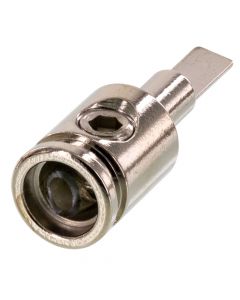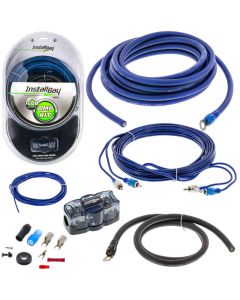We use cookies to make your experience better. To comply with the new e-Privacy directive, we need to ask for your consent to set the cookies. Learn more.
Autotek MM1125.1D 1,100 Watt Class D Mono Amplifier with wired bass boost control
- 1,100 Watt RMS 1-Channel Class D Car Amplifier
- Class D Design Offers Efficiency and High-Quality Sound
- Continuous Power Output (1 Ω, ≤ 1% THD+N): 1100 W x 1
- Continuous Power Output (2 Ω, ≤ 1% THD+N): 550 W x 1
- Continuous Power Output (4 Ω, ≤ 1% THD+N): 225 W x 1
Autotek MM1125.1D 1,100 Watt Class D Mono Amplifier with wired bass boost control
-
Features:
- 1,100 Watt RMS 1-Channel Class-D Car Amplifier
- MOSFET power supply for large power output
- LED power (green) and protect (red) indicators
- Variable Low-pass electronic crossover (40-240 Hz, 12 dB/octave)
- 3-way protection circuitry (thermal, overload, and speaker short protection)
- 12-Gauge single oversized speaker terminals simplify the hookup of multiple speakers
- Heavy duty aluminum alloy heat-sink
- Nickel-plated screw terminals
- 1 channel operation
- 4-gauge power and ground leads and a 50-amp fuse recommended
- Frequency Response: 10Hz to 500 Hz
- Signal to noise ratio: >90dB
- Total Harmonic Distortion (THD): <0.1% (1 kHz)
- Variable bass boost: 0 dB - 12 dB (50 Hz)
-
Inputs and Outputs:
- Single-channel operation
- Nickel-plated RCA level inputs and outputs
- Input Sensitivity Low level: 200mV-6.5V
-
Max Power Output:
- Total Power Output: 1,500 Watts
-
RMS Power Output:
- Continuous Power Output (1 Ω, ≤ 1% THD+N): 1100 W x 1
- Continuous Power Output (2 Ω, ≤ 1% THD+N): 550 W x 1
- Continuous Power Output (4 Ω, ≤ 1% THD+N): 252 W x 1
-
Built in Crossover:
- Low Pass: 40Hz - 300Hz @ 12dB/octave
- Subsonic: 40Hz - 40Hz @ 12dB/octave
-
Dimensions:
- Overall Dimensions: 3-1/4" (H) x 12-3/4" (L) x 7" (W)
| Manufacturer | Autotek |
|---|---|
| Part Number | MM1125.1D |
| Amplifier Topology Class | Class D |
| Number of Channels | 1 Channel |
| Total RMS Power at 1 ohm | 1,100.00 |
| Total RMS Power at 2 ohm | 550.00 |
| Total RMS Power at 4 ohm | 225.00 |
| RMS Output per Channel (x1 at 2 ohms) | 550.00 Watts |
| RMS Output per Channel (x1 at 1 ohms) | 1,100.00 Watts |
| RMS Output per Channel (x1 at 4 ohms) | 225.00 Watts |
| RMS Output per Channel (x2 at 4 ohms) | 0.00 Watts |
| RMS Output per Channel (x2 at 2 ohms) | 0.00 Watts |
| RMS Output per Channel (x4 at 4 ohms) | 0.00 Watts |
| RMS Output per Channel (x4 at 2 ohms) | 0.00 Watts |
| Total Peak Power Output | 1,100.00 (Watts) |
| Amplifier Bridging | Not Bridgable |
| Minimum Impedance in Bridged Mode | Not Bridgeable |
| Minimum Impedance in Un-Bridged Mode | 1 ohm |
| Strappable Amplifier | No |
| RCA Pre-amp Audio inputs | 1 Pair |
| RCA Pre-amp Audio outputs | None |
| Preamp voltage | 200 mV - 6 V |
| Gain Control | Yes |
| Bass Knob / Remote Gain | Yes |
| Built in Crossover | Low-pass, Sub-sonic |
| Cooling Fan | No |
| Color | Black |
| Warranty | 1 Year |
| Recommended Power Wire Gauge | 4 Gauge |
| Overall Height | 3.25 inches |
| Overall Length | 12.75 inches |
| Overall Width | 7.00 inches |
| CEA2006 Compliant | No |
| UPC Code | 806576232292 |
| Return period | 30 days |
| Exchange period | 30 days |
Car amplifier installation
We show you the complete process of installing a Pioneer Double DIN car stereo in a Chevy truck. The in-depth video shows the installation of the interface, and steering wheel control.
Amplifier Installation basics
Let's start with the basics of adding or installing a car amplifier. First you will need to plan your installation and power wiring, this usually is the most difficult part of the installation for most.
How to choose the proper wire size explained
What size power wire do I need for my amplifier? Well, that depends on the length of the wire and the power consumption of the amplifier. We walk you through how to choose the right gauge wire and wire material depending on your amplifier installation requirements.
How to wire speakers and subwoofers to your new amplifier
In our third video we demonstrate the various ways you can wire speakers and amplifiers to all types of amplifiers. There different ways to do this depending on the type of amplifier you choose to purchase.
What is gain? How do I set it properly?
In our fourth video we demonstrate how to set the gains on your amplifier to prevent damage to your speakers, subwoofers and even possibly your new amplifier. Using a portable oscilloscope we show you how to set your gains.











